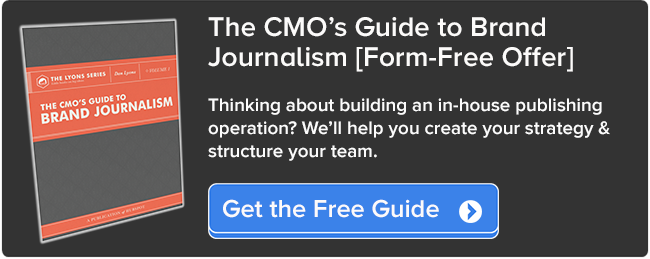 This is an excerpt from our new ebook, The CMO’s Guide to Brand Journalism. Download your free copy if you want to learn more about how to build a news organization, big or small, inside your company.
This is an excerpt from our new ebook, The CMO’s Guide to Brand Journalism. Download your free copy if you want to learn more about how to build a news organization, big or small, inside your company.
Call it what you will: brand journalism, corporate journalism, corporate media. More and more companies are creating “journalistic” content. Some are even hiring journalists and camera crews, building studios, and launching dedicated news sites to cover themselves and their industries.
Cisco, Intel, Microsoft, and Oracle all operate newsrooms. Maersk, the shipping company, has a news operation. So does Nissan, the Japanese automaker. LinkedIn has a managing editor. So does GE. Three big venture capital firms in Silicon Valley -- Sequoia Capital, Andreessen Horowitz and Battery Ventures -- have hired in-house journalists from the Wall Street Journal, Wired, and Forbes, respectively.
It’s not just big companies. Kapost, a small startup in Boulder, CO., hired Jesse Noyes, a former Boston Herald reporter, to run its content marketing operation. I’m another example. I’m the former technology editor at Newsweek, and now I’m a blogger at HubSpot.
If you’re the CEO or CMO of a mid-sized or large brand, you may have started thinking about building an in-house news operation of your own. To help you get there, we’ve created an ebook, The CMO’s Guide to Brand Journalism.
The book will help you structure a team and figure out what obstacles you should expect to encounter and how to get over them. We also explain the structure of a newsroom, and how to map that structure to a corporate environment.
Also provided is an explanation of four business models adopted by various companies. The four models are explained via case studies developed by interviewing journalists and executives at Microsoft, IBM, GE, Intel, Adobe, and other companies.
We also include a section explaining the unique challenges that a small company faces when trying to build a news or publishing operation. Finally, there are a set of "best practices" that apply in mainstream media and make sense for corporate news operations, as well.
Four Models
There are lots of ways to go about creating media inside a corporation. We’ll look at four models that are in use today. They are:
Brand Awareness
You’re publishing stories because you want people to know about your company. You’re not trying to generate sales directly from those articles. Examples: GE and IBM.
Industry News
You write about your own company and your industry, creating coverage that supplements the work of mainstream media. Examples: Intel and Microsoft.
Create and Sponsor
You want to establish your company as a thought leader, so you create an independent site. Example: Adobe’s CMO.com.
Lead Generation
You use content as a way to generate leads that can be converted into customers. Example: HubSpot.
Best Practices
There are some ways in which corporate journalism and traditional journalism should play by the same rules. Here are some best practices from the world of mainstream media that you can and should adopt in your corporate publishing operation:
Be transparent. Be honest about who you are and why you’re publishing this article. Sometimes you can’t avoid having a conflict of interest. That’s fine, but you should disclose it.
Don’t write ad copy. You can (and should) write about your company and your products. But there’s a way to do this that feels honest and legitimate.
Tell the truth. Ethics are the cornerstone of what you’re doing. Just like a newspaper reporter, you should be seeking to tell the truth at all times.
Have an opinion. People respond to content that comes with a point of view. Your point of view is what distinguishes you in the marketplace and defines you to customers.
Admit mistakes. If you goof up, admit it. Express your regret, and apologize. You will be amazed what happens next. Fessing up makes people trust you more. It shows people that you are human -- and honest.
Get people to contribute to your blog. Seek out people I call "megaphones," meaning they have a huge presence on social media. When they write for you, they will promote their article, and your brand will go along for the ride. If you can’t get them to write for you, the next best thing is to write about them.
Be promiscuous. Promiscuity is a virtue, at least in the world of publishing. LinkedIn, Huffington Post, Forbes, and others have huge audiences of business-savvy people. Try to write for them, or get them to syndicate articles that have already appeared on your blog. Do the same with industry publications from your market space, and the local paper. Your goal is to be in as many places as possible.
To learn more about building a newsroom inside your company, check out the form-free brand journalism guide.

How to Build a Newsroom Inside Your Company


No comments:
Post a Comment